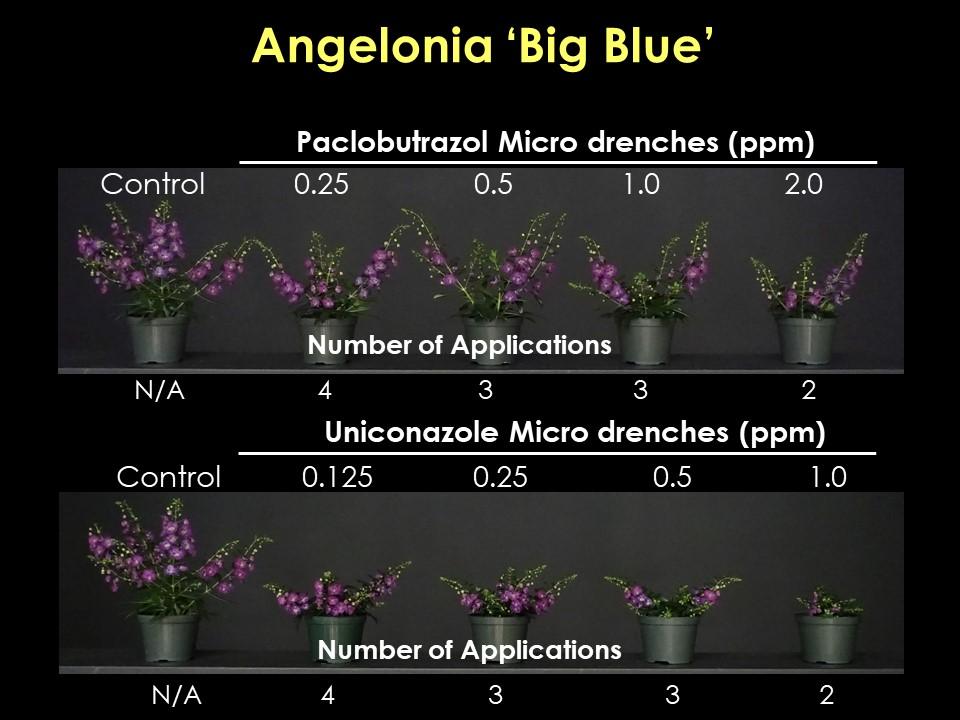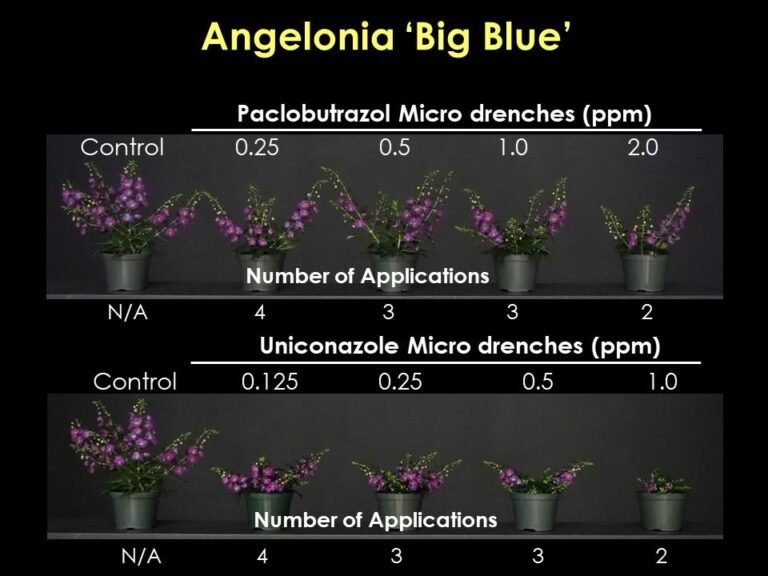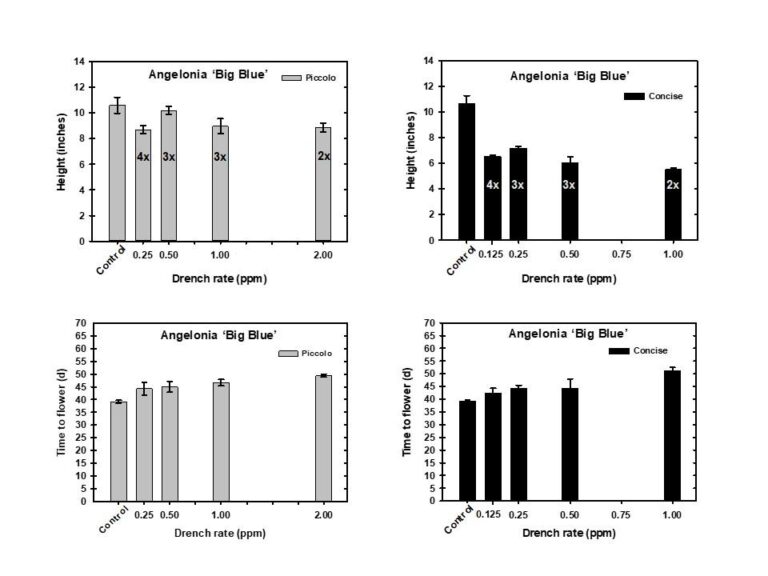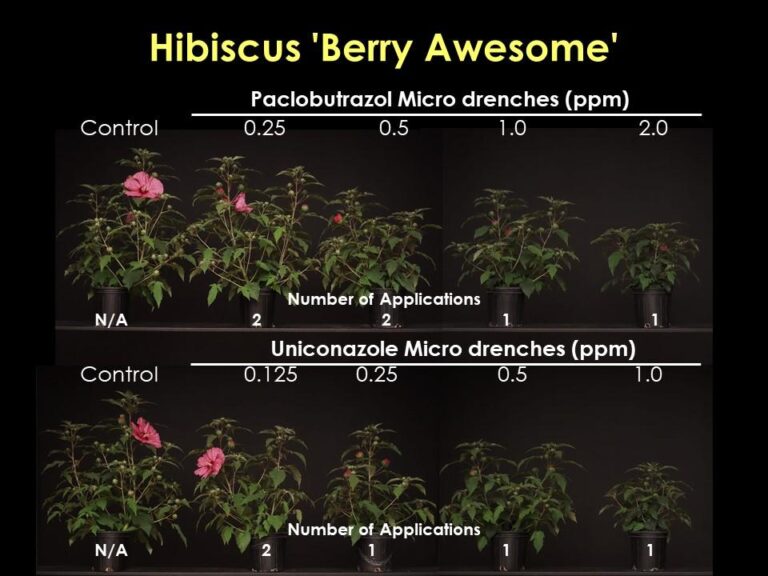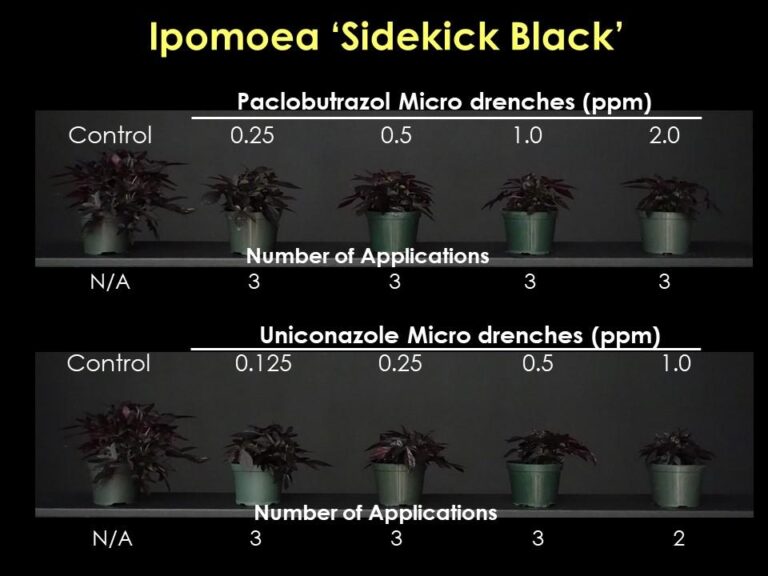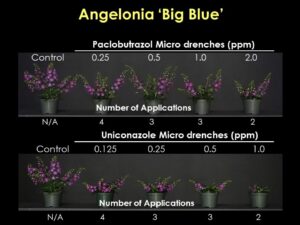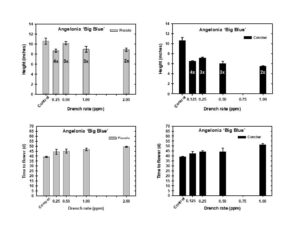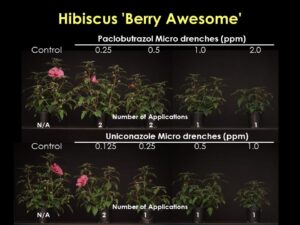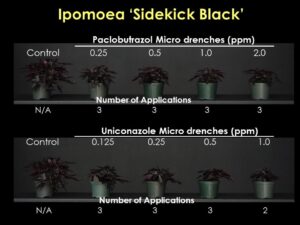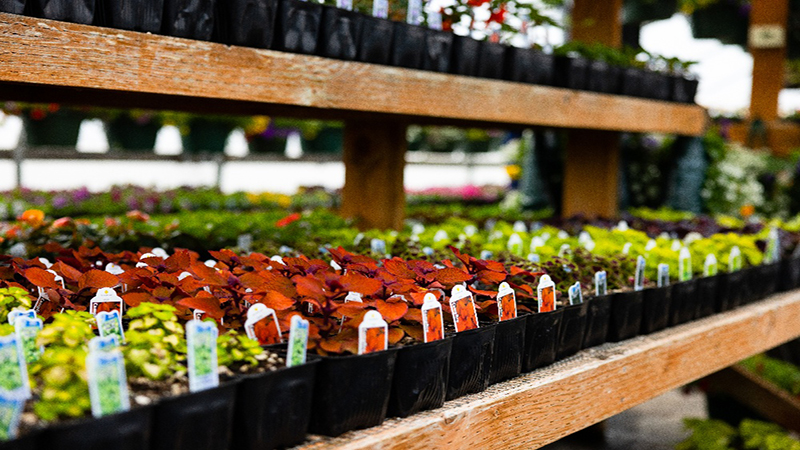Do Micro Drenches on Annuals and Perennials Really Work?
Plant growth regulators (PGRs) can be applied as sprays to the stems or leaves of plants, or to the growing substrate in the form of drenches, sprenches (hybrid of a spray and a drench), plug or liner dips, and bulb, rhizome, or tuber dips. A PGR drench is an application of a relatively large volume of a PGR solution to a substrate at a concentration approximately half or less of what is used in sprays.
Drenches are applied to inhibit extension growth of aggressive crops for a long period of time (e.g., petunia, sweet potato vine, etc.) or to stop extension growth once a plant reaches its final desired height (e.g., bulbs, Easter lilies, and poinsettias).
Substrates Impact on PGR Drench Effectiveness
A drench can provide a long-lasting response because the PGR is retained by the substrate components and is available to the roots over an extended period. Substrate composition can also affect the effectiveness of PGR drenches. It is well established that pine bark, when included in substrate, reduces the effectiveness of PGR drenches. Therefore, if you are drenching plants in substrates that contain pine bark, you may need to increase the active ingredient concentration by as much as 25% to achieve better height control. However, drench activity is unaffected by substrates containing rice hulls or standard or high-porosity wood fiber.
Drenches Versus Sprays
With drenches, the PGR is absorbed by the roots and transported to the growing points where it inhibits subsequent stem elongation. Drenches can be more desirable than spray applications because they are often only applied once, whereas sprays are often applied multiple times. In addition, sprays applied late in the production cycle can delay flowering or bract size of poinsettia, whereas drenches typically do not have this effect. However, drenches can be labor intensive depending on the delivery method. They should be applied to moist (but not excessively dry or wet) substrate, and none should leach out of the container. Lastly, if you utilize a subirrigation system to deliver a drench, reduce the rate by 25% to 50%.
Take Care the Product You Use Works Best for Drenches
Not all PGRs are effectively absorbed by roots, as is the case with daminozide (B-Nine and Dazide). PGRs with the active ingredient paclobutrazol (Bonzi, Downsize, Pac O, Piccolo, or Piccolo 10XC ) or uniconazole (Concise and Sumagic) are commonly used as drenches. Ancymidol (Abide and A-Rest), chlormequat chloride (Citadel and Cycocel), and flurprimidol (Topflor) are also effective, but either require large amounts to be effective or are cost prohibitive, while ethephon (Florel and Collate) is not registered for use as a substrate drench. As a drench, uniconazole is applied at rates 50% lower than those recommended for paclobutrazol. The appropriate volume of PGR drench solution depends on the size of the container as outlined in the table below.
Table 1: Volume Based on Container Size
The table below highlights the volume of plant growth regulator (PGR) required for various container sizes to provide micro drench rates of 0.125 to 2 ppm and milligrams of PGR active ingredient per container.
| Container Diameter (inches) | Drench Volume (fluid ounces/ container) | Micro Drench PGR Rate (ppm) | |||||
| 0.125 | 0.25 | 0.5 | 0.75 | 1 | 2 | ||
| milligram (mg) of PGR active ingredient/container | |||||||
| 4 | 2 | 0.0079 | 0.0158 | 0.0315 | 0.0473 | 0.063 | 0.125 |
| 5 | 3 | 0.0470 | 0.0235 | 0.047 | 0.0705 | 0.094 | 0.188 |
| 6 | 4 | 0.0156 | 0.0313 | 0.0625 | 0.0938 | 0.125 | 0.25 |
| 8 | 10 | 0.0391 | 0.0782 | 0.1565 | 0.2348 | 0.313 | 0.625 |
| 10 | 25 | 0.0979 | 0.1958 | 0.3915 | 0.5873 | 0.783 | 1.56 |
| 10-inch hanging basket | 15 | 0.0588 | 0.1175 | 0.235 | 0.3525 | 0.470 | 0.939 |
| 12 | 40 | 0.1563 | 0.3125 | 0.625 | 0.9375 | 1.25 | 2.5 |
The concept of applying several PGR micro drenches earlier and at a lower rate than one drench application is of increasing interest to greenhouse growers that are hesitant of drenches. Micro drenches are generally 1/8th to 1/10th of the traditional rates used for drenches and sprays. Based on previous research at the University of Florida and by SePRO Corporation utilizing Topflor on poinsettia, micro drenches can lead to toned and uniform plants throughout production. This ultimately requires less total PGR than one heavy or stop drench application and does not stunt plants for consumers, but it leaves more room for error.
Micro Drench Trials
Our objective was to determine if multiple, early, and low rate plant PGR substrate micro drenches of uniconazole or paclobutrazol can cost effectively control stem elongation of aggressive annual and perennial bedding plants. Plug and liner trays of Angelonia ‘Alonia Big Blue’, Calibrachoa ‘Kabloom Pink Blast’, Dianthus ‘Rockin Red’, hardy hibiscus ‘Summerific Berry Awesome’, New Guinea impatiens ‘Bounce Cherry Impatiens’, sweet potato vine ‘Sidekick Black’, Petunia ‘Surfinia Sumo Pink’, snapdragon ‘Solstice Yellow’, Verbena ‘EnduraScape Red’, and Petunia ‘Wave Carmine’ were received and placed in greenhouses at the Plant Science Research Greenhouses at Michigan State University. Plants were grown at an average daily temperature of 68°F, daily light integral of 10 to 12 mo1∙m–2∙d–1, and under a 16-hour photoperiod from high-pressure sodium lamps.
Young plants were transplanted into 5-inch, 6-inch, or 2-gallon containers filled with a commercial soilless substrate composed of 70% peat moss, 21% perlite, and 9% vermiculite. Five to six days after transplant, a substrate drench containing 0.25, 0.50, 1, or 2 ppm paclobutrazol (Piccolo; Fine Americas, Inc.), or 0.125, 0.25, 0.50, or 1 ppm uniconazole (Concise; Fine Americas, Inc.), or reverse osmosis water (untreated control) was applied at a volume of 3 or 4 fluid ounces per 5-inch or 6-inch container, respectively. Plants were fertilized with 125 ppm nitrogen from a balanced feed at each irrigation.
Height measurements of angelonia, dianthus, New Guinea impatiens, lantana, petunia, hibiscus, and snapdragon or the length of the longest verbena, sweet potato vine, and Wave petunia stem were recorded weekly and graphically tracked to assist with subsequent PGR micro drench applications.
What We Learned
Generally, three micro drench applications of paclobutrazol at 0.5 to 1 ppm were effective at controlling angelonia, dianthus, perennial hibiscus, sweet potato vine, lantana, and upright petunia. Time to flower was either not delayed or delayed by up to 10 days depending on the crop (Table 2 and Figure 2). With the exception of angelonia, two to three micro drench applications of uniconazole at 0.125 to 0.25 ppm were effective for these same crops (Figures 1 to 4).
Table 2: Making Best Use of PGRs
The table below highlights the effective rates and number of uniconazole or paclobutrazol micro drench applications required to produce compact and marketable crops and potential delay in time to flower.
| Crop | Uniconazole (ppm) and [number of applications] | Flowering delay (days) | Paclobutrazol (ppm) and [number of applications] | Flowering delay (days) |
| Angelonia | Rates too high | 3 to 12 | 0.25 [4 applications]
0.5 [3 applications] 1.0 [3 applications] |
5 to 8 |
| Dianthus | 0.125 [3 applications] | No delay | 0.50 [3 applications]
1.0 [3 applications] 2.0 [3 applications] |
1 to 6 |
| Hibiscus | 0.25 [1 application]
0.5 [1 application] |
5 to 6 | 0.50 [2 applications]
1.0 [1 application] |
3 to 5 |
| Lantana | 0.125 [3 applications]
0.25 [3 applications] |
No delay | 0.25 [3 applications]
0.5 [3 applications] 1.0 [3 applications] |
No delay |
| New Guinea impatiens | Rates too high | |||
| Upright Petunia | 0.125 [3 applications]
0.25 [3 applications] 0.5 [3 applications] 1.0 [3 applications] |
No delay to 9 | 0.25 [4 applications]
0.5 [3 applications] 1.0 [3 applications] 2.0 [3 applications] |
No delay to 10 |
| Snapdragon | 0.125 [4 applications] | 1 | 0.25 [4 applications]
0.5 [4 applications] |
No delay to 2 |
| Sweet Potato Vine | 0.125 [3 applications]
0.25 [3 applications] 0.5 [3 applications] 1.0 [2 applications] |
N/A | 0.25 [4 applications]
0.5 [3 applications] 1.0 [3 applications] 2.0 [3 applications] |
N/A |
| Verbena | 1.0 [3 applications] | No delay | 1.0 [3 applications] | No delay |
| Wave Petunia | 1.0 [5 applications] | 8 | 1.0 [6 applications]
2.0 [6 applications] |
4 to 7 |
With uniconazole micro drenches, time to flower was either not delayed or delayed up to 12 days (Table 2 and Figure 2). Higher rates of paclobutrazol or uniconazole or additional applications at 0.5 to 1 ppm (paclobutrazol) or 0.5 to 1 ppm (uniconazole), might be effective for aggressive cultivars of verbena and petunia. We found that the rates and frequency we utilized were excessive on the New Guinea impatiens cultivar we tested.
As with any new PGR application method, we recommend you conduct small trials with micro drenches before implementing on a large scale. Effective rates were determined under March to May greenhouse conditions in a northern latitude. Therefore, higher rates or more applications may be necessary in southern locations.
Footnote: The author gratefully acknowledges Fine Americas, Inc. for chemicals and funding, the Western Michigan Greenhouse Association for funding, Raker Roberta’s Young Plants, Walters Gardens, and Mast Young Plants for plant material, The Blackmore Co. for fertilizer, and Nathan DuRussel, Jacob Brunner, and Anthony Soster for greenhouse assistance.
Micro Drench Guidelines
- Do not utilize on slow-growing species or cultivars
- Apply within five to seven days of transplanting plugs or liners
- Subsequent applications should be made within seven days
- Increase rates by up to 25% if your substrate contains bark
- Apply to moist (but not excessively dry or wet) substrate
- Conduct small trials to determine appropriate rates for your crops and environmental and cultural conditions.





